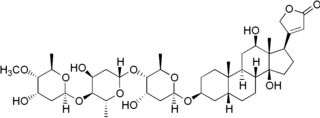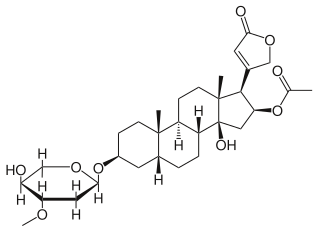
Cardiac glycosides are a class of organic compounds that increase the output force of the heart and decrease its rate of contractions by inhibiting the cellular sodium-potassium ATPase pump. Their beneficial medical uses are as treatments for congestive heart failure and cardiac arrhythmias; however, their relative toxicity prevents them from being widely used. Most commonly found as secondary metabolites in several plants such as foxglove plants, these compounds nevertheless have a diverse range of biochemical effects regarding cardiac cell function and have also been suggested for use in cancer treatment.

Digitalis is a genus of about 20 species of herbaceous perennial plants, shrubs, and biennials, commonly called foxgloves.

Digoxin, sold under the brand name Lanoxin among others, is a medication used to treat various heart conditions. Most frequently it is used for atrial fibrillation, atrial flutter, and heart failure. Digoxin is one of the oldest medications used in the field of cardiology. It works by increasing myocardial contractility, increasing stroke volume and blood pressure, reducing heart rate, and somewhat extending the time frame of the contraction. Digoxin is taken by mouth or by injection into a vein. Digoxin has a half life of approximately 36 hours given at average doses in patients with normal renal function. It is excreted mostly unchanged in the urine.

Dofetilide is a class III antiarrhythmic agent. It is marketed under the trade name Tikosyn by Pfizer, and is available in the United States in capsules containing 125, 250, and 500 µg of dofetilide. It is not available in Europe or Australia.

Amiodarone is an antiarrhythmic medication used to treat and prevent a number of types of cardiac dysrhythmias. This includes ventricular tachycardia (VT), ventricular fibrillation (VF), and wide complex tachycardia, as well as atrial fibrillation and paroxysmal supraventricular tachycardia. Evidence in cardiac arrest, however, is poor. It can be given by mouth, intravenously, or intraosseously. When used by mouth, it can take a few weeks for effects to begin.

Flecainide is a medication used to prevent and treat abnormally fast heart rates. This includes ventricular and supraventricular tachycardias. Its use is only recommended in those with dangerous arrhythmias or when significant symptoms cannot be managed with other treatments. Its use does not decrease a person's risk of death. It is taken by mouth or injection into a vein.

Phytochemistry is the study of phytochemicals, which are chemicals derived from plants. Phytochemists strive to describe the structures of the large number of secondary metabolites found in plants, the functions of these compounds in human and plant biology, and the biosynthesis of these compounds. Plants synthesize phytochemicals for many reasons, including to protect themselves against insect attacks and plant diseases. The compounds found in plants are of many kinds, but most can be grouped into four major biosynthetic classes: alkaloids, phenylpropanoids, polyketides, and terpenoids.

Cerberin is a type of cardiac glycoside, a steroidal class found in the seeds of the dicotyledonous angiosperm genus Cerbera; including the suicide tree and the sea mango. This class includes digitalis-like agents, channel-blockers that as a group have found historic uses as cardiac treatments, but which at higher doses are extremely toxic; in the case of cerberin, consumption of the C. odollam results in poisoning with presenting nausea, vomiting, and abdominal pain, often leading to death. The natural product has been structurally characterized, its toxicity is clear—it is often used as an intentional human poison in third-world countries, and accidental poisonings with fatalities have resulted from individuals even indirectly consuming the agent—but its potentially therapeutic pharmacologic properties are very poorly described.

Digitalis lanata, vernacularly often called woolly foxglove or Grecian foxglove, is a species of foxglove, a flowering plant in the plantain family Plantaginaceae. It gets its name due to the woolly indumentum of the leaves. D. lanata, like other foxglove species, is toxic in all parts of the plant. Symptoms of digitalis poisoning include nausea, vomiting, severe headache, dilated pupils, problems with eyesight, and convulsions at the worst level of toxicity. The plant is also harmful to other animals.

Metildigoxin is a cardiac glycoside, a type of drug that can be used in the treatment of congestive heart failure and cardiac arrhythmia. The substance is closely related to digoxin; it differs from the latter only by an O-methyl group on the terminal monosaccharide.

A cardenolide is a type of steroid. Many plants contain derivatives, collectively known as cardenolides, including many in the form of cardenolide glycosides (cardenolides that contain structural groups derived from sugars). Cardenolide glycosides are often toxic; specifically, they are heart-arresting. Cardenolides are toxic to animals through inhibition of the enzyme Na+/K+‐ATPase, which is responsible for maintaining the sodium and potassium ion gradients across the cell membranes.

k-Strophanthidin is a cardenolide found in species of the genus Strophanthus. It is the aglycone of k-strophanthin, an analogue of ouabain. k-strophanthin is found in the ripe seeds of Strophanthus kombé and in the lily Convallaria.

Digoxin immune fab or digoxin-specific antibody is an antidote for overdose of digoxin. It is made from immunoglobulin fragments from sheep that have already been immunized with a digoxin derivative, digoxindicarboxymethoxylamine (DDMA). Its brand names include Digibind (GlaxoSmithKline) and DigiFab.

Gitoformate is a cardiac glycoside, a type of drug that can be used in the treatment of congestive heart failure and cardiac arrhythmia. Produced by Madaus, it is not available in the US, and does not seem to be available in Europe either.

Deslanoside is a cardiac glycoside, a type of drug that can be used in the treatment of congestive heart failure and cardiac arrhythmia. It is found in the leaves of Digitalis lanata, the Woolly Foxglove.

Lanatoside C is a cardiac glycoside, a type of drug that can be used in the treatment of congestive heart failure and cardiac arrhythmia. Lanatoside C can be used orally or by the intravenous route. It is marketed in a number of countries and is also available in generic form. Its main indications are rapid response atrial fibrilation and paroxysmal supraventricular tachycardia, two common types of arrhythmia.

Oleandrin is a cardiac glycoside found in the poisonous plant oleander. As a main phytochemical of oleander, oleandrin is associated with the toxicity of oleander sap, and has similar properties to digoxin.

Digoxin toxicity, also known as digoxin poisoning, is a type of poisoning that occurs in people who take too much of the medication digoxin or eat plants such as foxglove that contain a similar substance. Symptoms are typically vague. They may include vomiting, loss of appetite, confusion, blurred vision, changes in color perception, and decreased energy. Potential complications include an irregular heartbeat, which can be either too fast or too slow.

Convallatoxin is a glycoside extracted from Convallaria majalis.

Calotropin is a toxic cardenolide found in plants in the family Asclepiadoideae. In extreme cases, calotropin poisoning can cause respiratory and cardiac failure. Accidental poisoning is common in livestock who have ingested milkweed. Calotropin is commonly stored as a defense mechanism by insects that eat milkweeds as their main food source.




















